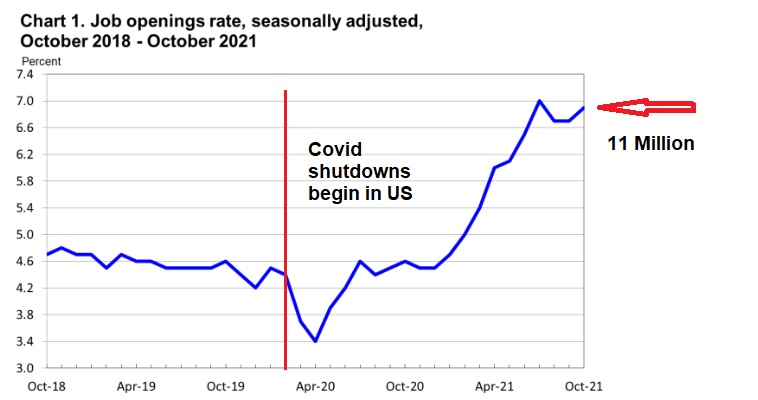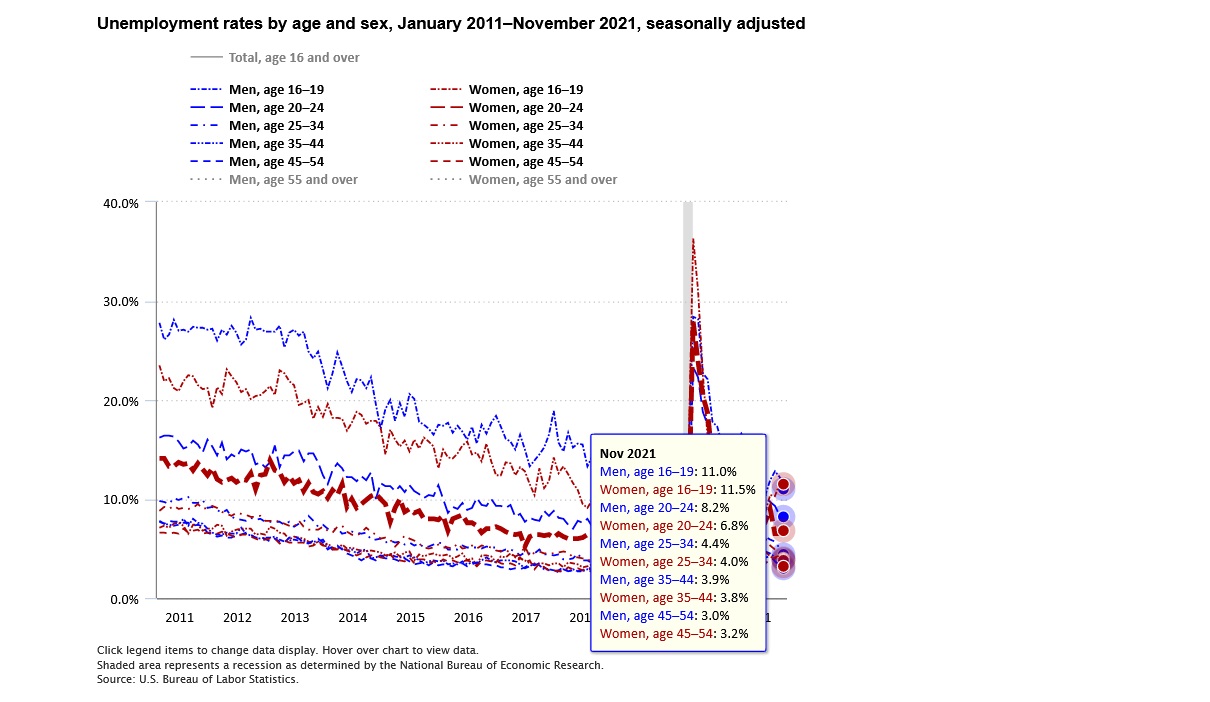SHI 12.8.21 – People Wanted, Apply Within

SHI 12.1.21 – Money Talks
December 1, 2021
SHI 12.15.21 – Land of the Free. Home of the Brave.
December 15, 2021People. We’re short people. Everywhere.
Our labor markets — at least here in the US — need people. Globally, many nations are not creating enough new people. They need more new people. People: Let me tell you, it’s a mess.
“
Where is everyone? “
“Where is everyone? “
The Bureau of Labor Statistics reported today that US employers were seeking 11-million people to fill open positions at the end of October. When you consider the fact that this number — pre-pandemic — use to hover around 5-million, you have to ask: Where are all the people we need to fill these jobs? Somewhat related, tangentially anyway, for the first time in history, fertility in India has fallen below “replacement level.” Meaning that India’s population will begin to shrink far sooner that experts expected. Said another way, India is not creating enough new people. But then again, neither is China, Japan, France, Germany, Spain … well, the list is rather long and includes most countries in the northern hemisphere.
Why we seeing so many “job openings?” And why should we care about fertility rates? Because both adversely impact the SHI! How is that possible, you ask? Let me explain.
Welcome to this week’s Steak House Index update.
If you are new to my blog, or you need a refresher on the SHI10, or its objective and methodology, I suggest you open and read the original BLOG: https://www.steakhouseindex.com/move-over-big-mac-index-here-comes-the-steak-house-index/
Why You Should Care: The US economy and US dollar are the bedrock of the world’s economy.
But is the US economy expanding or contracting?
Expanding. Significantly. In fact, in the 6 months of Q2 and Q3, growth nominal terms exceed $1.1 trillion of economic activity. The world’s annual GDP is expect to end 2021 near about $93 trillion. Annualized, America’s GDP settling in at $23.17 trillion — still around 25% of all global GDP. Collectively, the US, the euro zone, and China still generate about 70% of the global economic output. These are your big players.
The objective of this blog is singular.
It attempts to predict the direction of our GDP ahead of official economic releases. Historically, ‘personal consumption expenditures,’ or PCE, has been the largest component of US GDP growth — typically about 2/3 of all GDP growth. In fact, the majority of all GDP increases (or declines) usually results from (increases or decreases in) consumer spending. Consumer spending is clearly a critical financial metric. In all likelihood, the most important financial metric. The Steak House Index focuses right here … on the “consumer spending” metric. I intend the SHI10 is to be predictive, anticipating where the economy is going – not where it’s been.
Taking action: Keep up with this weekly BLOG update. Not only will we cover the SHI and SHI10, but we’ll explore “fun” items of economic importance. Hopefully you find the discussion fun, too.
If the SHI10 index moves appreciably -– either showing massive improvement or significant declines –- indicating growing economic strength or a potential recession, we’ll discuss possible actions at that time.
The Blog:
Truth be told, neither impact the SHI today. And the impact from the 11-million job openings is hard to predict. But that fertility rate thing, that’s a serious economic issue. Let’s begin with today’s JOLTs report from the BLS. Here’s a graph from today’s report:

Employers are desperate to find workers. They are offering higher wages and all sorts of other interesting and creative perks. But the tug-of-war for the same person is disruptive for the employer. On the other hand, employees are enjoying their sudden popularity. What’s caused this disruption? In a word: Covid. Covid shutdowns in the US began around February of March of 2020. Millions of jobs were lost. Employers stopped hiring. Job openings fell to a new low. But then, somewhat inexplicably, demand for new workers began to rise … then plateau … and then shoot WAY up. What happened?
As we know from numerous media reports, millions of people who were previously working somewhere in the economy seem to have left. Have they gone fishing?
Regardless, they are no longer working … nor are they seeking a new job. Depending on who you ask, and what data source you use, that number is somewhere between 2-million and 4-million people. At a high level, this is reflected in the dramatic post-pandemic drop in the “Labor Force Participation Rate.” Why aren’t people “participating” in the labor force? Great question. Again, there are many opinions … including a report I read earlier today where the author opined that 2- or 3-million people are suffering from “long Covid.” Meaning they were infected with Covid, and long after they text negative, they still feel quite poor. Too poor, in fact, to work. This may explain some portion of the problem, but I think there’s another explanation: I think its fear. I think the media has scared the pants off millions of folks … they are so afraid of catching Covid, they are staying home.
But this is just my opinion. and frankly the “why” is less important than the “what” — especially if you’re an employer looking for new hires. If you are an employer, what can you do about it? Arm yourself with data is my answer. And then act accordingly. You may be surprised to learn that the unemployment rates are dramatically different depending on age cohort. Consider these stark differences between groups of older and younger workers:

As you can see above, the unemployment rate for men and women between 45-54 is in the low 3% range. Yet for the age group between 16 and 19, the unemployment rate is over 11%. And it’s above 8% for men between 20 and 24. Employers: If you’re desperate for employees to fill your open positions, build a marketing campaign to recruit younger folks between 16 and 24. There’s a lot more of younger folks looking for jobs than older folks. For you fishermen out there, let me say it another way: Given the choice to fish in an empty trout pond, or one that has just been freshly stocked, which pond will you pick? Correct. The answer is obvious. Go “fish” for some younger people.
Speaking of younger people, much of the world doesn’t have enough of them. Pre-pandemic, fertility rates were already quite low. Today, they are lower still. India has joined much of the developed world: Their country is now on the path to shrink. No, not right away … but this outcome is almost inevitable. Consider this comment from the Economist magazine:
“The number of Indians will still grow, because many young women have yet to reach child-bearing age. But lower fertility means the population will peak sooner and at a lower figure: not in 40 years at more than 1.7bn, as was widely predicted, but probably a decade earlier, at perhaps 1.6bn.”
Even more fascinating is the fact that India is not alone in this predicament. Consider this image, courtesy of the World Bank:

The fertility rate in majority of the northern hemisphere is below replacement levels. Absent large amounts of immigration, populations on North America will shrink in the coming decades. Not today. And probably not for the next 25 or 30 or so years … but this outcome is almost inevitable. Even Mexico is at or below a replacement fertility rate. Simply stated: We need more people, or we’re gonna shrink.
You may be wondering why Terry is talking about demographics … when this is supposed to be an economics blog? Because they are intertwined. And inseparable. Over the past 100 or so years, the combination of a growing population, expanding GDP per capita, and increased productivity have enriched the world. Imagine if this long-term trend reverses? I’ll talk more about this in future blogs. But make no mistake: We need more people. Get to work! 🙂
Good news! Our steak houses don’t need more people. This week, they’re full of people!

NYC is packed. Only one reservation remains for this next Saturday, and that’s at 9pm. OC is the same. Reservation demand in most cities is quite high. ‘Tis the season! Every year, it seems, expensive steak house reservations are in high demand right about now. As we can see in the longer term trend.

The only ‘red’ we’re seeing this week is from Santa’s outfit. Our pricey eateries are doing quite well, thank you very much. Thanks for tuning in. Happy Holidays!
<:> Terry Liebman




